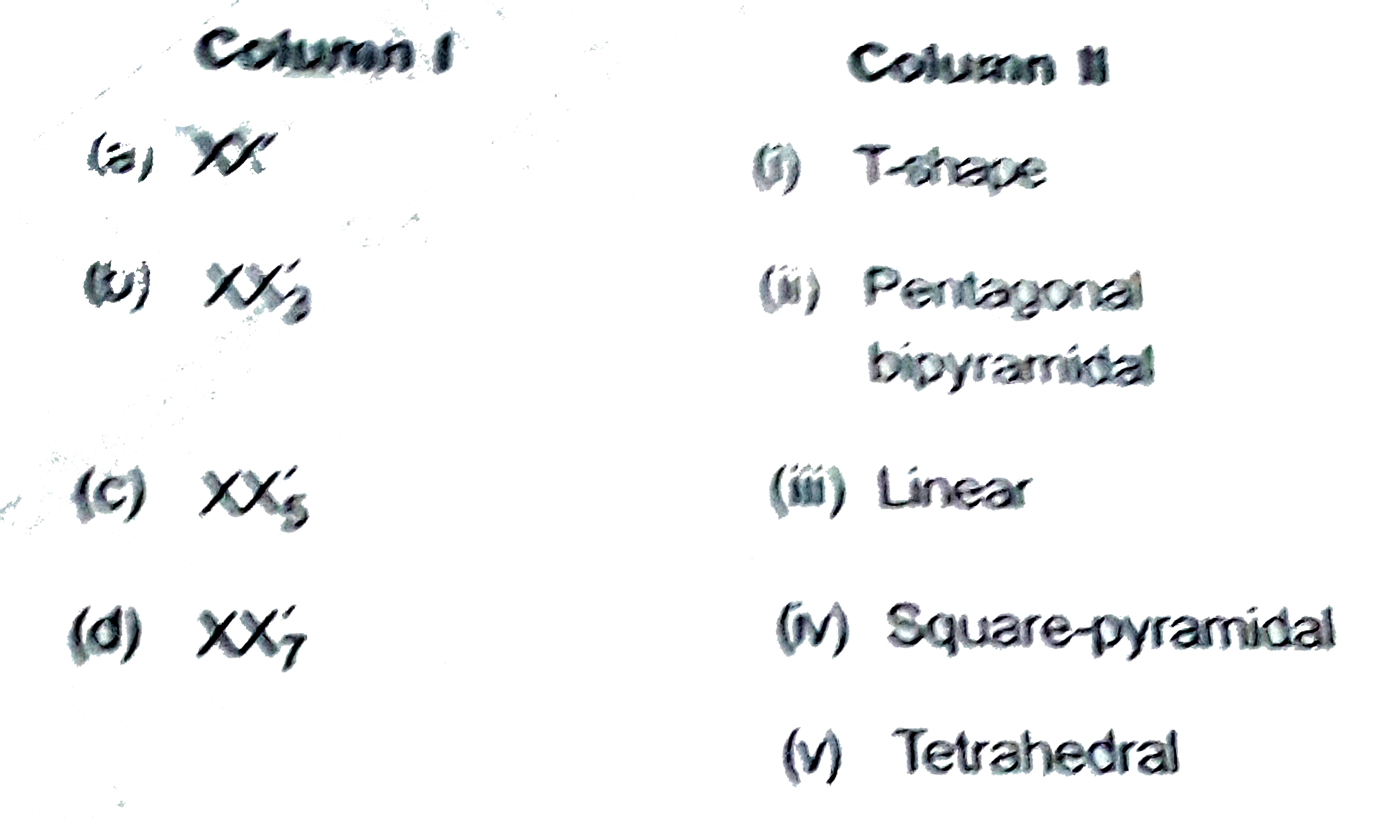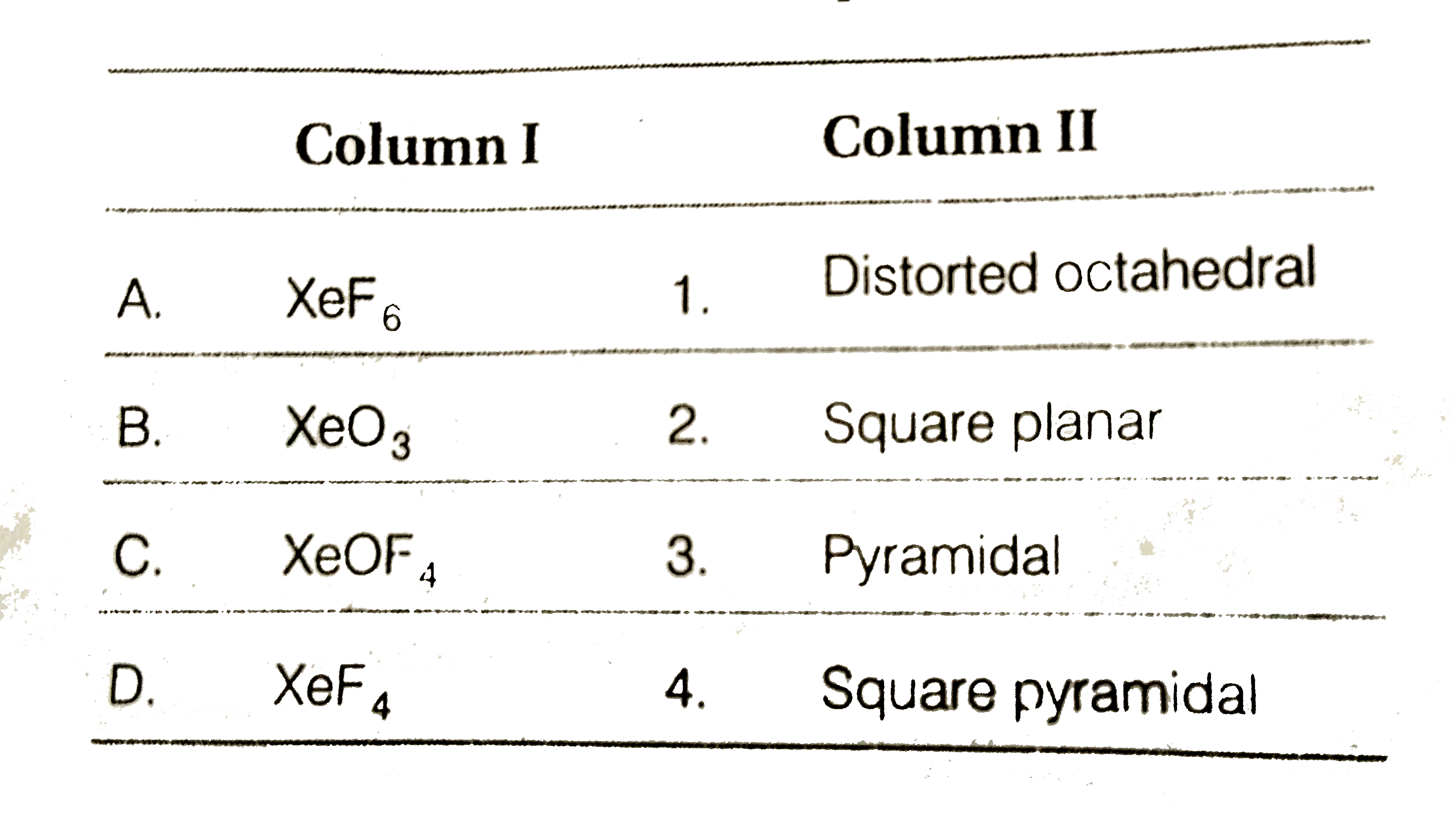Complete Solutions to Exercise of chapter P-BLOCK ELEMENTS of Class 12 book with complete answers and questions
| Class 12 | CHEMISTRY |
| Chapter | P-BLOCK ELEMENTS |
| NEET PREVIOUS YEAR | Exercise |
| Number Of Questions | 100 |
| Academic Year | 2023-24 |
The species, having bonds angle of `120^(@)` is
View SolutionMatch the interhalogen compounds of column I with the geometry in column II and assign the correct code

View SolutionWhich of the following pairs of compound is isoelectronic and isostructure ?
View SolutionIt is because of inability of `ns^(2)` electrons of the valence shell to participate in bonding that:
View SolutionIn which pair of ions both the species contains `S - S` bond?
View SolutionMatch the compounds given in Column I with the hybridisation and shape given in column II and mark the correct option.

View SolutionWhich of the following statement is correct for the given acids?
View SolutionAmong the following, the correct order of acidity is:
View SolutionWhich one of the following orders is correct for the bond dissociation enthalpy of halogen molecules?
View SolutionBoric acid is an acid because its molecule
View Solution`AIF_(3)` is soluble in `HF` only in presence of `KF`. It is due to the formation of
View SolutionHot concentrated sulpuric acis is a moderatly strong oxidizing agent. Which of the following reaction does not shwo oxidizing behaviour?
View SolutionThe correct geometry and hybridisation for `XeF_(4)` are
View SolutionAmong the following ,which one is the wrong statement
View SolutionNitrogen dioxide and sulphur dioxide have some properties in common, which property is shown by one of these compounds, but not by the other?
View SolutionMaximum bond angle at nitrogen is present in which of the following ?
View SolutionIn which of the following pairs, both the species are not isostructural?
View SolutionDecreasing order of stability of `O_(2), O_(2)^(-), O_(2)^(+)` and `O_(2)^(2-)` is
View SolutionThe stability of `+1` oxidation state increases in the sequence :
View SolutionWhich of the statements given below is incorrect ?
View SolutionThe formation of oxide ion `O^(2-)(g)` from oxygen atom requires first an exothermic and then an endothermic step as shown below
`O(g)+e^(-) rarr O^(-)(g), DeltaH^(-) = - 141 kj mol^(-1)`
`O^(-)(g) +e^(-) rarr O^(2-) (g), DeltaH^(-) =+ 780 kj mol^(-1)`
Thus, process of formation of `O^(2-)` in gas phase is unfavourable even through `O^(2-)` is isoelectronic with neon. It is due to the fact that A) oxygen is more electronegative B) addition of electron in oxygen results in larget size of the ion C) electron repulsion outweights the stability gained by achieving noble gas configuration D) `O^(-)` ion has comparatively smaller size than oxygen atom
View SolutionThe variation of the boiling points of the hydrogen halides is in the order `HFgtHIgtHBrgtHCl`.
What explains the higher boiling point of hydrogen fluoride?
View SolutionStrong reducing behaviour of `H_(3)PO_(2)` is due to
View SolutionAcidity of diprotic acids in aqueous solutions increases in the order
View SolutionWhich of the following structure is similar to graphite e?
View SolutionThe basic structural unit of silicates is
View Solution`XeF_(2)` is isostructural with
View SolutionWhich of these is not a monomer for a high-molecular mass silicone polymer?
View SolutionWhen `Cl_(2)` gas reacts with hot and concentrated sodium hydroxide solution, the oxidation number of chlorine changes from
View SolutionWhich of the following statement is not valid for oxoaids of phosphorus?
View SolutionSulphur trioxide can be obtained by which of the following reactions:
View SolutionName the type of the structure of silicate in which one oxygen atom of `[SiO_(4)]^(4-)` is shared
View SolutionOxidation states of `P` in `H_(4)P_(2)O_(5), H_(4)P_(2)O_(6)` and `H_(4)P_(2_)O_(7)`, respectively are
View SolutionWhich one of the following molecules hydrides acts as a Lewis acid ?
View SolutionThe tendency of `bF_(3), BCl_(3)` and `BBr_(3)` behave as Lewis acid decreases in the sequnece
View SolutionThe stability of `+1` oxidation state increases in the sequence :
View SolutionThe straight chain polymer is formed by
View SolutionAmong the following which is the strongest oxidising agent?
View SolutionWhich one of the following arrangements does not give the correct picture of the trends indicated against it ?
View SolutionWhich of the following anions is present in the chain structure of silicates?
View SolutionWhich one of the following ionic species has the greatest proton affinity to form stable compound ?
View SolutionWhich of the following oxidation states are the most characteristics for lead and tin, respectively?
View SolutionWhich of the following is the most basic oxide ?
View Solution`Al_(2)O_(3)` can be converted to anhydrous `AlCl_(3)` by heating
View SolutionWhich one of the following orders is not in according with the property stated against it ?
View SolutionWhich of the following is the electron-deficient molecule?
View SolutionWhich one of the following arrangements represents the correct order of electron gain enthalpy of the given atomic species?
View SolutionWhich one of the following oxides is expected to exhibit paramagnetic behaviour?
View SolutionAmong `K,Ca,Fe` and `Zn` the element which can form more than one binary compound with chlorine is
View SolutionWhich is the best decription of behaviour of bromine in the reaction given below ?
`H_(2)O + Br_(2) HBR + HOBr`
View SolutionWhich of the following statements about the zeolites is false?
View SolutionWhich one of the following compounds is not a protoric acid?
View SolutionWhich of the following statements is not true ?
View SolutionThe oxidation states of sulphur in the anions `SO_(3)^(2-), S_(2)O_(4)^(2-)`, and `S_(2)O_(6)^(2-)` follow the order
View Solution`Zn` gives `H_(2)` gas with `H_(2)SO_(4)` and `HCl` but not with `HNO_(3)` because
View SolutionIn borax bead test, which compound is formed?
View SolutionWhich of the following statements is true ?
View SolutionWhich of the following reaction is not feasible?
View SolutionNitrogen forms `N_(2)` but phosphorous when forms `P_(2)` gets readily converted into `P_(4)` because
View SolutionAmong the following the electron deficient compound is
View SolutionWhich one of the following arrangement does not truly represent the property indicated against it ?
View SolutionWhich of the following is used in the prepration of chlorine ?
View SolutionWhich of the following phosphorus is the most reactive?
View SolutionPercentage of lead in lead pencil is
View SolutionWhich of the following does not show electrical conductance?
View SolutionWhich of the following is most acidic ?
View SolutionWhich one of the elements has the maximum electron affinity?
View SolutionA one litre flask is full of brown bromine vapour. The intensity of brown colour of vapour will not decreases appreciably on adding to the flask some
View SolutionRepeated use of which one of the following fertilizers would increase the acidity of the soil?
View Solutionthe correct structural formula of hypophosphorous acid is
View SolutionWhich of the following statement is `//`are correct regarding `F^(-)` and `CI^(-)`
(i) `Cl^(-)` can give up an electron more easily than `F^(-)`
(ii) `Cl^(-)` is smaller in size than `F^(-)`
(iii) `Cl^(-)` is a better reducing agent then `F^(-)`
(iv) `F^(-)` can be oxidized more readily than `Cl^(-)`
View SolutionOxidation of thiosulphate by iodine gives
View SolutionWhich of the following oxides will be the least acidic?
View SolutionWhich of the followign compounds has a 3-centre bond ?
View SolutionThe structure and hybridisation of organometallic `Si(CH_(3))_(4)` is
View SolutionAn aqueous solution of sodium carbonate absorbs `NO` and `NO_(2)` to yield
View SolutionAbout `20km` above the earth ,there is an ozone layer ,Which one of the following statement about ozone and ozone layer is true?
View SolutionWhich of the following oxides of chlorine is obtained by passing dry chlorine over silver chlorate at `90^(@)C`.
View SolutionWhich among the following is paramagnetic ?
View SolutionWhich of the following statement is false ?
View SolutionNoble gases do not react with other elements because
View SolutionWhich of the following acids has a peroxy linkage?
View SolutionPolyanion formation is maximum in
View SolutionWhich of the following is incorrect for `H_(3)BO_(3)`
View SolutionIn graphite, electrons are
View SolutionA solution of `KBr` is treated with each of the following which one would liberate bromine?
View SolutionWhich of the following species has four lone..
View SolutionThe pronounced change from non-metallic behaviour and also increase in the basicity of oxides from nitrogen to bismuth in group `15` is principally due to incresing size of the atoms. The ionisation potential of nitrogen is very high on account of its small size. However, ionisation potential decreases regularly on descending the group.
Which one of the following fluorides does not exist ?
View SolutionIn the manufacture of bromine from sea water the mother liquor containing bromide is treated with
View Solutionstrongest hydrogen bonding is shown by
View SolutionElements of which of the following groups will form anions most readily ?
View SolutionWhich of the following bonds will be most polar?
View Solution`H_(3)PO_(2)` is the molecular formula of an acid of phosphorus. Its name and basicity respectively are
View SolutionNitrogen is relatively inactive element because
View SolutionCane sugar on reaction with nitric acid gives
View SolutionNumber of electrons shared in the formation of nitrogen molecules is
View SolutionWater gas is produced by
View SolutionWhich of the following forces bind together carbon atoms in diamond?
View SolutionWhich is used in the laboratory for last drying of neutral gases?
View Solutionthe bleaching action of chlorine is due to
View Solution
Exercise questions and complete solutions for chapter P-BLOCK ELEMENTS of NEET PREVIOUS YEAR (YEARWISE + CHAPTERWISE) of Class 12